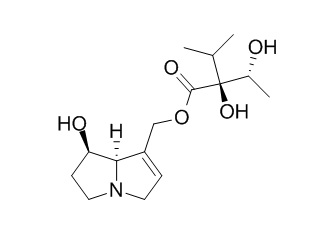Intermedine
Intermedin (IMD), a multi-functional peptide, plays important roles in cardiovascular protection, the endogenous IMD and its receptor complexes are induced in hypertrophic cardiomyocytes and proposed to play an important role in the pathogenesis of cardiac hypertrophy. Intermedin can decrease the melanin content of the skin of Rana pipiens.
Inquire / Order:
manager@chemfaces.com
Technical Inquiries:
service@chemfaces.com
Tel:
+86-27-84237783
Fax:
+86-27-84254680
Address:
1 Building, No. 83, CheCheng Rd., Wuhan Economic and Technological Development Zone, Wuhan, Hubei 430056, PRC
Providing storage is as stated on the product vial and the vial is kept tightly sealed, the product can be stored for up to
24 months(2-8C).
Wherever possible, you should prepare and use solutions on the same day. However, if you need to make up stock solutions in advance, we recommend that you store the solution as aliquots in tightly sealed vials at -20C. Generally, these will be useable for up to two weeks. Before use, and prior to opening the vial we recommend that you allow your product to equilibrate to room temperature for at least 1 hour.
Need more advice on solubility, usage and handling? Please email to: service@chemfaces.com
The packaging of the product may have turned upside down during transportation, resulting in the natural compounds adhering to the neck or cap of the vial. take the vial out of its packaging and gently shake to let the compounds fall to the bottom of the vial. for liquid products, centrifuge at 200-500 RPM to gather the liquid at the bottom of the vial. try to avoid loss or contamination during handling.
Comparative Clinical Pathology 2021, 30:961-971.
Hum Exp Toxicol.2022, 41:9603271221143713.
Cell Mol Biol (Noisy-le-grand).2023, 69(15):167-173.
Int J Vitam Nutr Res.2022, doi: 10.1024.
Int J Mol Sci.2021, 22(8):4211.
Food Chem.2021, 377:131976.
J Clin Transl Hepatol.2023, 11(4):863-876.
J Anal Methods Chem.2024, 2024:7703951.
Appl. Sci. 2021, 11(10),4666.
J Ethnopharmacol.2020, 269:113752.
Related and Featured Products
Plos One, 2013, 8(8):e64757.
Intermedin Suppresses Pressure Overload Cardiac Hypertrophy through Activation of Autophagy[Pubmed:
23737997]
Left ventricular hypertrophy is a maladaptive response to pressure overload and an important risk factor for heart failure. Intermedin (Intermedine,IMD), a multi-functional peptide, plays important roles in cardiovascular protection.
METHODS AND RESULTS:
In this study, we revealed an autophagy-dependent mechanism involved in IMD’s protection against cardiac remodeling and cardiomyocyte death in heart hypertrophy. We observed that transverse aortic contraction (TAC) induction, Ang II or ISO exposure induced remarkable increase in the expression of endogenous IMD and its receptor components, CRLR, RAMP1 and RAMP3, in mouse hearts and H9c2 cell cultures, respectively. Furthermore, the heart size, heart weight/body weight ratios, cardiomyocyte size and apoptosis, interstitial collagen, hypertrophic markers including ANP and BNP expression were also significantly increased, which were effectively suppressed by IMD supplementation. In addition, IMD induced capillary angiogenesis and improved functions in hypertrophic hearts. We further observed that IMD induced strong autophagy in hypertrophic hearts and cultured cells, which was paralleling with the decrease in cardiomyocyte size and apoptosis. Furthermore, an autophagy inhibitor, 3-MA, was used to block the IMD-augmented autophagy level, and then the protection of IMD on cardiomyocyte hypertrophy and apoptosis was almost abrogated. We also observed that IMD supplementation stirred intracellular cAMP production, and augmented the ERK1/2 phosphorylation induced by Ang II/ISO exposure in H9c2 cells. In addition, we inhibited PI3K, PKA and MAPK/ERK1/2 signaling pathways by using wortamannin, H89 and PD98059, respectively, in H9c2 cells co-incubating with both IMD and Ang II or ISO, and observed that these inhibitors effectively reduced IMD-augmented autophagy level, but only H89 and PD98059 pre-incubation abrogated the anti-apoptotic action of IMD.
CONCLUSIONS:
These results indicate that the endogenous IMD and its receptor complexes are induced in hypertrophic cardiomyocytes and proposed to play an important role in the pathogenesis of cardiac hypertrophy, and the autophagy stirred by IMD supplementation is involved in its protection against cardiomyocyte hypertrophy and apoptosis through the activation of both cAMP/PKA and MAPK/ERK1/2 pathways.
Experientia, 1982,38(9):1085-1087.
Pyrrolizidine alkaloids fromSymphytum officinale L. and their percutaneous absorption in rats[Reference:
WebLink]
.
METHODS AND RESULTS:
An analysis of a commercial sample of Symphyti radix originating from Poland with a total alkaloid content of 0.07% revealed the presence of 7 pyrrolizidine alkaloid-N-oxides: 7-acetyl Intermedine, 7-acetyl lycopsamine as the main constituents and lycopsamine, Intermedine, symphytine and traces of 2 further not yet identified alkaloids. The percutaneous absorption of these alkaloids was investigated in rats, using a crude alcoholic extract of the plant corresponding to a dose of 194 mg alkaloid-N-oxides/kg b.wt. The excretion of N-oxides in the urine during 2 days was in the range of 0.1–0.4% of the dose.
CONCLUSIONS:
The dermally absorbed N-oxides are not or only to a small extent converted to the free alkaloids in the organism. The oral application led to a 20–50 times higher excretion of N-oxides and free alkaloids in the urine.
Proc Soc Exp Biol Med. 1951 May;77(1):35-7.
Effect of administration of intermedin upon melanin content of the skin of Rana pipiens.[Pubmed:
14844386]
METHODS AND RESULTS:
The administration of intermedin(Intermedine), prepared from hog pituitary glands, results in a decrease, after four weeks, of twenty per cent in the melanin content of the skin of Rana pipiens. Subsequently, there is a rapid increase, reaching levels 40% above normal after a total of 8 weeks.
Edgar in Experientia,1981,37(7):683.
Alkaloids ofConoclinium coelestinum (L.) DC.,Eupatorium compositifolium walt., andE. altissimum L.: Isolation of crystalline intermedine fromC. coelestinum[Reference:
WebLink]
METHODS AND RESULTS:
The isolation of crystalline Intermedine fromConoclinium, coelestinum (L.) DC., notmixed with the diastereoisomeric congener base lycopsamine, is reported.E. compositifolium Walt. yielded the usual mixture of Intermedine and lycopsamine; fromE. altissimum L. rinderine and 7-angelylheliotridine have been isolated.



